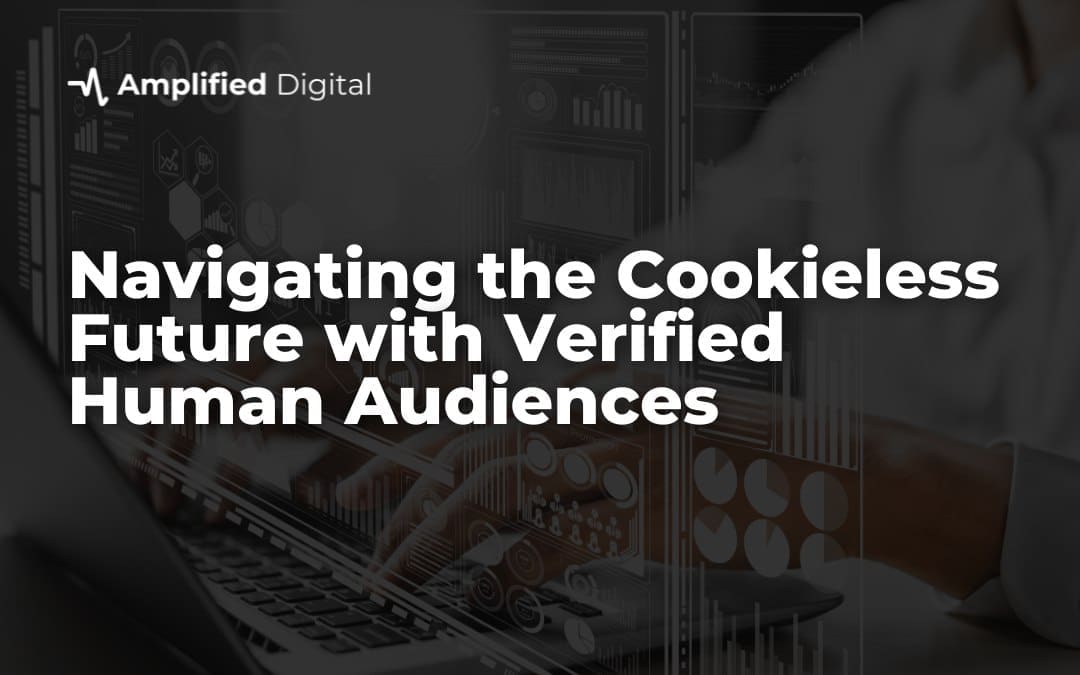In the swiftly evolving digital landscape, your ability to reach real people matters more than ever.
As we navigate towards a cookieless future, where traditional tracking methods fade into obsolescence, embracing a “Verified Human Audience” becomes crucial for maintaining genuine user engagement. This concept ensures you’re connecting with actual individuals, not bots or misrepresented data—a game-changer in how you strategize and measure online interactions.
Get ahead by understanding this pivotal shift now; it’s not just about adapting to change but seizing an opportunity to refine your audience approach in the cookieless era of the digital age.
What’s the Answer to a Cookieless Future?
A “Verified Human Audience” refers to a group of individuals who have been authenticated to be real human beings, as opposed to bots or automated scripts, typically in the context of digital interactions or online platforms. Verification methods may include CAPTCHA tests, two-factor authentication, behavioral analysis, and other forms of digital identification that ensure a person is genuine before including them within your audience.
This concept is particularly important in areas such as digital advertising, and social media engagement where the presence and actions of real humans carry significant value and implications. Ensuring an audience is verified as human helps maintain the integrity of data while building your audience without 3rd party cookies.
Understanding the Shift from Cookies to Cookieless Tracking

New Technologies
The cookieless future challenges you to explore new tracking technologies. Without third-party cookies, identifying unique users becomes tricky. However, innovative solutions are emerging.
Firstly, consider first-party data. You can collect this directly from your audience through forms and interactions on your site. It’s valuable because it’s obtained with consent and is highly relevant. Be careful when collecting first party data, as there are many newer laws such as GDPR that regulate what you do with collected data.
Secondly, look into universal IDs. These are identifiers that use a combination of online and offline data points to recognize users across different platforms without relying on cookies.
Thirdly, contextual advertising is regaining popularity. Ads relate to the content being viewed rather than past user behavior.
Lastly, machine learning algorithms predict user preferences based on aggregated data patterns rather than individual tracking.
Amplified Digital Agency can assist businesses in the cookieless world by leveraging data insights to create effective audience targeting strategies that don’t rely on traditional tracking cookies. With our expertise, we help businesses adapt to changing privacy regulations and connect with their target audience using ethical and innovative methods.
What Happens When Cookies Disappear?
Join us for an enlightening panel discussion hosted by the Richmond Times Dispatch. Dive into the evolving landscape of digital marketing as we explore the imminent disappearance of third-party cookies and its profound impact on advertisers, agencies, and consumers alike.
The Rise of First-Party Data and Consent in Marketing
Data Collection Shift
With the decline of third-party cookies, you have to now focus more on first-party data. This means gathering information directly from your customers. It’s a shift to a more transparent relationship where trust is key.
You collect this data through interactions on your own websites or apps. Think sign-up forms, surveys, and purchase histories. These methods ensure that customer data stays within your control.
User Consent
User consent has become crucial in marketing strategies. You need explicit permission to use personal data for advertising or analysis purposes. This is part of respecting privacy laws and building consumer trust.
When users visit your site, they encounter clear opt-in policies. They choose whether to share their information with you. Obtaining informed consent means explaining how you’ll use their data in simple terms.
Gaining user consent also builds a stronger audience because they are more trusting of your brand and product that they allow you to utilize their information.
Transparent Policies
Your opt-in policies must be straightforward for users to understand what they agree to. Transparency ensures that consent status remains valid under strict compliance rules. Transparency is the trend going forward. People like doing business with businesses they can trust.
Displaying these policies prominently helps avoid any confusion about data processing activities. Users appreciate knowing what happens with their personal details after collection.
Exploring Cookieless Solutions for Audience Verification
Fingerprinting Adoption
Your journey to understand your audience doesn’t end with the shift away from third-party cookies. Fingerprinting technology offers a new path. It gathers information about devices and browsers to create unique profiles. Imagine every device as a puzzle, with pieces like language settings and screen resolution fitting together to form an identifiable picture.
Machine learning takes this further by analyzing patterns in data. These algorithms improve over time, making insights more accurate. You can see which marketing strategies work best or what content resonates most without infringing on privacy.
Email Alternatives
Another strategy involves hashed email addresses. When users sign up for services or newsletters, their email address becomes a key identifier. Hashing transforms the email into a unique code that protects user identity while allowing you to track interactions across sessions and devices.
This method respects user consent gathered in previous steps of your marketing funnel. It’s secure because hashed emails are difficult to reverse-engineer back into personal information, safeguarding against breaches. Data breaches are a leading cause of a lot of the backlash of third-party cookies and companies collecting so much information about users.
Universal ID Integration
Universal IDs offer consistency in tracking without relying on cookies. They work by linking different identifiers across platforms into one stable profile for each user—like having one ID card for all digital activities.
Integrating a Universal ID system significantly streamlines the understanding of customer behavior by providing a unified view that transcends individual platforms and devices. This not only diminishes the dependence on any single platform for customer data, but also substantially improves the ability to track user activity across multiple devices.
By leveraging such an integration, businesses can gain a more holistic and accurate picture of their customer’s interactions and preferences, leading to more targeted and effective marketing strategies.
The Impact of Privacy Concerns on Digital Marketing Strategies
Privacy-First Models
With the shift away from cookies, your marketing strategies must adapt. Privacy-first advertising models are now essential. These models respect user privacy while still reaching target audiences. Business can still continue while protecting user data.
One example is a loyalty program where customers willingly share information in exchange for rewards. This approach aligns with both data protection laws and consumer desires for transparency.
Another method involves contextual targeting, placing ads based on content rather than user behavior. For instance, an ad for running shoes appears alongside a sports article—not because the reader has been tracked, but because of the article’s subject matter.
Targeting Tactics
Your tactics must change to meet new privacy regulations without losing effectiveness. Gone are the days of relying solely on third-party cookies to understand customer interests. Now you need innovative ways to gather insights while respecting privacy.
You can revise your approach by enhancing segmentation using available first-party data or investing in predictive analytics that anticipate needs without intruding into personal spaces.
Consider partnerships with platforms that users trust which can provide aggregated data insights without compromising individual privacy risks.
At Amplified we make sure to stay up-to-date on the latest tracking methods and use our expertise to build you a Verified Human Audience.
Personalization Balance
Balancing personalization with consumer expectations about their privacy is tricky but doable. Customers appreciate personalized experiences but not at the cost of their privacy rights.
To strike this balance, be transparent about how you collect and use data—clear communication builds trust and mitigates concerns over privacy risks.
For example, when offering product recommendations, explain why those suggestions appear: “Based on items you’ve viewed.” This clarity shows respect for both their preferences and their right to know how their data informs your marketing efforts.
Adapting to Cookieless Advertising and Retargeting

Contextual Targeting
With privacy concerns shaping digital marketing, you must explore new methods. Contextual targeting is a powerful alternative. It aligns ads with content relevance rather than user behavior.
For example, if your website offers cooking recipes, contextual targeting would place kitchenware ads alongside relevant articles. This method ensures that the audience seeing your ad is already interested in related topics.
Unlike traditional client-side cookies, this strategy doesn’t track users but matches the subject matter of the page to specific ad types. It’s less invasive and respects user privacy while still allowing effective ad placement.
Publisher Partnerships
Direct collaboration with publishers opens doors for tailored advertising opportunities. By partnering with website owners directly, you gain access to their audiences without needing cookies.
This approach allows for sharing click information and other non-personal data that can help tailor your advertising campaigns more effectively within a publisher’s platform.
Imagine working closely with a popular tech blog to promote your electronics store; they may provide insights into what kind of products their readers are interested in based on article popularity or comments without revealing individual data points about their visitors.
Amplified Digital Agency has you covered here. We have access to over 70 Owned & Operated local news sites throughout the United States that have strong local audiences. By working with us, we can get ads next to relevant content with ease and build you a Verified Human Audience of strong local buyers.
Innovative Retargeting
To keep up in a cookieless future, innovative retargeting tactics are essential:
- Fingerprinting: Uses details like device type or browser version instead of cookies.
- Probabilistic Matching: Infers possible connections between devices based on patterns.
These methods don’t rely on traditional cookies but still enable some level of personalized advertising by understanding broader user trends across various platforms.
You might see an uptick in ad clicks through these methods as they allow for continued personalization even when direct tracking isn’t possible due to regulations limiting the use of advertising cookies.
Preparing for Cookieless Analytics and Attribution Models
Server-Side Tracking
As you move away from reliance on third-party cookies, server-side tracking becomes critical. This method offers more control over data collection and privacy. It involves sending data directly from your servers to analytics services. Unlike client-side tracking, it reduces the risk of data loss due to browser restrictions.
You can expect accurate traffic measurement with this setup. The process starts by integrating server-side scripts that handle user interactions on your website. These scripts then relay information back to your servers where it’s processed securely.
Server-side tracking also helps in tracking conversions effectively without relying on third-party cookies. Your conversion data will be more reliable when handled through secure server processing.
Model-Based Attribution
In a cookieless future, developing a robust attribution model is imperative for understanding how various channels contribute to conversions. You’ll need new ways to measure success since traditional single-touch models won’t suffice.
A model-based approach allows you to distribute credit among all touchpoints in a customer journey. For instance, if someone first finds your brand through an ad but converts after reading a blog post, both actions should be considered in the attribution.
Consider using algorithms or machine learning techniques for sophisticated modeling that adapts over time as consumer behaviors change.
Multi-Touch Systems
Emphasizing multi-touch attribution (MTA) systems is essential as they offer a holistic view of customer journeys across different channels and touchpoints. MTA systems help you understand not just the final click before conversion but the entire pathway leading up to it. It’s very closely related to an attribution model.
By employing MTA systems, you can allocate marketing resources more efficiently because they provide insights into which channels are most effective at different stages of the funnel.
Pros:
- Comprehensive view of customer pathways.
- Better resource allocation based on channel effectiveness.
- Complexity in setting up and maintaining MTA systems.
To set these up properly requires careful planning around data collection and analysis methods used within your organization’s infrastructure.
Google’s Transition to a Cookieless Approach and Its Alternatives
Privacy Sandbox
With the cookieless future looming, you may wonder about Google’s next steps. The tech giant is developing the Privacy Sandbox. This initiative aims to protect users’ privacy on the web while giving advertisers tools for effective marketing.
The Privacy Sandbox proposes several technologies. They balance personal privacy with ad relevance. One such tool is FLoC, which we’ll explore more below.
Google promises these changes won’t harm your advertising efforts. Yet, it will take time to adapt and master these new tools.
Our experts at Amplified are always on top of new tools and requirements, so if you do work with us, you don’t have to worry about keeping up with all of it, and you can focus on what you do best.
Federated Learning
Federated Learning of Cohorts (FLoC) stands out among alternatives to cookies. It groups users into cohorts based on similar browsing behaviors. Your ads reach people with shared interests without individual tracking.
This approach respects user privacy better than cookies ever did. However, some worry about its effectiveness compared to traditional methods.
To stay ahead, you should keep an eye on FLoC developments and test early once available.
Non-Google Networks
Don’t forget other players in the digital space as you navigate this change. Non-Google ad networks offer various technology solutions that might fit your needs well during this transition period. These platforms often have their own ways of targeting ads without relying on third-party cookies.
Exploring them could yield valuable insights or even lead to better results for your campaigns. You can find opportunities beyond what Google offers by looking at different websites and approaches within the industry.
Embracing Verified Human Audiences for Business Growth

Verified Human Audiences are crucial in the digital marketing world going forward, where ad fraud and non-human traffic can significantly waste advertisers’ budgets, and where tracking with 3rd party cookies no longer exists. By verifying that the audience is composed of real humans, advertisers can be confident that their messages are being seen by potential customers, leading to more effective campaigns and better ROI.
Amplified Digital Agency can assist clients with our Owned & Operated (O&O) properties through Lee Enterprises by leveraging strategies that do not rely on traditional cookies and tracking methods. Instead of using third-party data, Amplified Digital Agency can help businesses to utilize first-party data and contextual targeting techniques. This data is inherently more reliable and valuable because it comes straight from the source—the audience themselves.
By focusing on first-party data collection and analysis, Amplified Digital Agency can help clients create personalized experiences for their audiences without infringing on privacy or relying on soon-to-be-obsolete third-party cookies.
Moreover, by emphasizing the importance of Verified Human Audiences, Amplified Digital Agency ensures that these personalized experiences are delivered to real people, maximizing the impact of advertising efforts and safeguarding against the inefficiencies associated with non-human traffic. This approach not only prepares clients for a cookieless future but also aligns with increasing consumer demand for privacy and responsible data usage.
Final Remarks
The cookieless future is not a distant reality but an evolving present that demands your attention and adaptability.
As we’ve navigated through the complexities of a world without third-party cookies, it’s clear that embracing first-party data, consent-driven marketing, and innovative verification methods is imperative for your business’s growth.
The transition necessitates a strategic pivot towards privacy-focused digital marketing strategies, leveraging Google’s alternatives and novel personalization techniques.
Amplified Digital Agency is your partner to stay on top of the latest tracking methods and privacy issues, as well as provide the platforms for reaching your ideal human audience.
Contact Amplified today and learn how our O&O properties and marketing expertise can help make sure your business doesn’t hit a slump in this new, cookieless world.
Frequently Asked Questions
What is the cookieless future in digital marketing?
The cookieless future refers to a shift away from relying on third-party cookies for tracking user behavior and targeting ads, driven by privacy concerns and regulatory changes.
How are marketers adapting to the loss of third-party cookies?
Marketers are increasingly turning to first-party data, obtained with user consent, and exploring new technologies for audience verification that do not rely on cookies.
Why is first-party data becoming more important?
First-party data is crucial as it’s collected directly from customers with their consent, making it more reliable and compliant with privacy regulations.
What impact do privacy concerns have on digital marketing strategies?
Privacy concerns demand that marketers prioritize transparency and user consent, leading to more ethical practices in collecting and using consumer data.
How will retargeting work without third-party cookies?
Retargeting will leverage alternative methods like first-party data, contextual targeting, or device fingerprinting to serve relevant ads without needing third-party cookies.
Can analytics still be effective in a cookieless world?
Yes. Analytics can use first-party data along with new attribution models designed for the cookieless environment while respecting user privacy.
How is Google responding to the transition towards a cookieless web?
Google is developing Privacy Sandbox initiatives aimed at creating web standards that protect privacy while giving advertisers tools they need.


